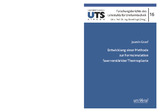Citation link:
http://dx.doi.org/10.25819/ubsi/10425| DC Field | Value | Language |
|---|---|---|
| dc.contributor.author | Graef, Jasmin | - |
| dc.date.accessioned | 2024-01-08T11:01:15Z | - |
| dc.date.available | 2024-01-08T11:01:15Z | - |
| dc.date.issued | 2023 | de |
| dc.description.abstract | Bauteile aus gewebeverstärkten Thermoplasten werden für den Leichtbau im Automobilbereich eingesetzt. Nach Erwärmung oberhalb des Schmelzbereichs lassen sich diese mit Thermoformverfahren zu Bauteilen formen. Die mechanischen Eigenschaften werden durch die nach dem Formprozess im Bauteil vorliegenden Faserwinkel im Verstärkungsgewebe sowie auftretender Falten beeinflusst. Somit liegt ein großes Intersse in der Entwicklung und Verbesserung von Simulationsmethoden zur Vorhersage der Faserwinkel und Faltenbildung. Die vorliegende Arbeit fokussiert sich auf die Entwicklung eines FE-Modells zur Abbildung des Formverhaltens von gewebeverstärkten Polyamiden und Polypropylenen mit ABAQUS/EXPLICIT und der Materialversuche zur Charakteriseirung der Scher-, Zug-, Druck- und Biegesteifigkeiten bei Formtemperatur in einer Wärmekammer, für die es bisher keine Standardisierung gibt. Zur Validierung des Modells werden Formversuche eines DoubleDome Demonstrators an einer Presse durchgeführt und die Ausprägung der Faserwinkel und Falten des fertigen Bauteils quantifiziert. Dies umfasst die Entwicklung eines Programms zur Ermittlung der Faserwinkel von Bauteilen und Proben der aterialversuche. Anhand von Sensitivitätsanalysen des FEM-Modells werden der Einfluss der einzelnen Eingabeparameter der Materialkarten sowie deren Wechselwirkungen untersucht. Auf dieser Grundlage wird eine ganzheitliche Methode zur Formsimulation faserverstärkter Thermoplaste entwickelt. Dies umfasst die Kennwertertmittlung und deren Implementierung ins FE-Modell bis hin zur Simulation der Bauteilformung. Die Methode wird anhand der Simulation eines Bumperquerträgers validiert. | de |
| dc.description.abstract | Fabric-reinforced thermoplastics are used for lightweight parts within automotive components. They can be formed using thermoforming processes after heating above the melting temperature of the thermoplastics. The fiber angles and the wrinkling of the final parts influence the mechanical properties. Thus, there is a great interest in the development and improvement of simulation methods for the prediction of fiber angles and wrinkling. The present work focuses on the development of an FE model to represent the forming behavior of fabric-reinforced polyamides and polypropylene with ABAQUS/EXPLICIT and the implementation of material tests for the shear, tensile, compressive and bending stiffnesses at forming temperature within a heating chamber. Currently, there is no standardization for the material tests. To validate the model, forming tests of a double dome demonstrator are carried out on a press and the fiber angles and wrinkling of the final parts are measured. This includes the development of a program to determine the fiber angles of the components and samples of the material tests. The influence of the individual input parameters of the material cards and their interactions are examined using sensitivity analyzes of the FE model. On this basis, a holistic method for the forming simulation of fiberreinforced thermoplastics is being developed. The method includes the determination of material parameters and their implementation into the FE model up to the forming simulation of the component. Finally, the method will be validated within the simulation of a bumper cross member. | en |
| dc.identifier.doi | http://dx.doi.org/10.25819/ubsi/10425 | - |
| dc.identifier.uri | https://dspace.ub.uni-siegen.de/handle/ubsi/2637 | - |
| dc.identifier.urn | urn:nbn:de:hbz:467-26375 | - |
| dc.language.iso | de | de |
| dc.relation.ispartofseries | Forschungsberichte des Lehrstuhls für Umformtechnik | de |
| dc.rights | Namensnennung - Weitergabe unter gleichen Bedingungen 4.0 International | * |
| dc.rights.uri | http://creativecommons.org/licenses/by-sa/4.0/ | * |
| dc.source | Siegen: universi - Universitätsverlag Siegen, 2023. - ISBN 978-3-96182-161-7 | de |
| dc.subject.ddc | 620 Ingenieurwissenschaften und zugeordnete Tätigkeiten | de |
| dc.subject.other | Gewegeverstärkte Thermoplaste | de |
| dc.subject.other | Einheitszelle Faltenbildung | de |
| dc.subject.other | Materialcharakterisierung | de |
| dc.subject.other | Scherwinkel | de |
| dc.subject.other | Faserwinkel | de |
| dc.subject.other | Thermoformen | de |
| dc.subject.other | FEM-Simulation | de |
| dc.title | Entwicklung einer Methode zur Formsimulation faserverstärkter Thermoplaste | de |
| dc.title.alternative | Development of a method for the forming simulation of fiber-reinforced thermoplastics | en |
| dc.type | Doctoral Thesis | de |
| item.fulltext | With Fulltext | - |
| item.seriesid | 69 | - |
| ubsi.contributor.referee | Engel, Bernd | - |
| ubsi.date.accepted | 2023-03-16 | - |
| ubsi.extern.issn | 2191-0030 | - |
| ubsi.organisation.granting | Universität Siegen | - |
| ubsi.origin.dspace5 | 1 | - |
| ubsi.origin.universi | 1 | - |
| ubsi.publication.affiliation | Institut für Produktionstechnik | de |
| ubsi.relation.issn | 2191-0030 | - |
| ubsi.relation.issuenumber | 16 | de |
| ubsi.source.extern-issue | 16 | de |
| ubsi.source.extern-title | Forschungsberichte des Lehrstuhls für Umformtechnik | de |
| ubsi.source.isbn | 978-3-96182-161-7 | - |
| ubsi.source.issued | 2023 | de |
| ubsi.source.place | Siegen | de |
| ubsi.source.publisher | universi - Universitätsverlag Siegen | de |
| ubsi.source.title | Entwicklung einer Methode zur Formsimulation faserverstärkter Thermoplaste | de |
| ubsi.subject.ghbs | ZIO | de |
| Appears in Collections: | Hochschulschriften Universi | |
Files in This Item:
| File | Description | Size | Format | |
|---|---|---|---|---|
| UTS_16_Graef.pdf | 14.63 MB | Adobe PDF |  View/Open |
This item is protected by original copyright |
Page view(s)
274
checked on Nov 24, 2024
Download(s)
87
checked on Nov 24, 2024
Google ScholarTM
Check
Altmetric
This item is licensed under a Creative Commons License


